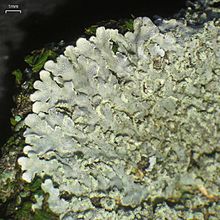Physconia
| Physconia | |
|---|---|

| |
| Physconia enteroxantha | |
| Scientific classification | |
| Domain: | Eukaryota |
| Kingdom: | Fungi |
| Division: | Ascomycota |
| Class: | Lecanoromycetes |
| Order: | Caliciales |
| Family: | Physciaceae |
| Genus: | Physconia Poelt (1965) |
| Type species | |
| Physconia pulverulenta (Hoffm.) Poelt (1965) | |
Physconia is a genus of lichen-forming fungi in the family Physciaceae. It has about 25 species.[1] The genus was circumscribed by Czech lichenologist Josef Poelt in 1965, with Physconia pulverulenta assigned as the type species.[2]
Species
- Physconia californica Essl. (2000)[3]
- Physconia chinensis J.B.Chen & G.R.Hu (2003)[4]
- Physconia distorta (With.) J.R.Laundon (1984)[5]
- Physconia enteroxantha (Nyl.) Poelt (1966)
- Physconia fallax Essl. (2000)[3]
- Physconia grisea (Lam.) Poelt (1965)
- Physconia jacutica Urbanav., Ahti & Loht. (2007)[6]
- Physconia labrata Essl., McCune & Haughland (2017)[7]
- Physconia muscigena (Ach.) Poelt (1965)
- Physconia perisidiosa (Erichsen) Moberg (1977)
- Physconia pulverulenta (Schreb.) Poelt (1965)
- Physconia rossica Urbanav. (2008)[6]
- Physconia sikkimensis (Jatta) D.D.Awasthi (2007)
- Physconia thorstenii A.Crespo & Divakar (2007)[8]
References
- ^ Wijayawardene, N.N.; Hyde, K.D.; Dai, D.Q.; Sánchez-García, M.; Goto, B.T.; Saxena, R.K.; et al. (2022). "Outline of Fungi and fungus-like taxa – 2021". Mycosphere. 13 (1): 53–453. doi:10.5943/mycosphere/13/1/2. hdl:10481/76378.
- ^ Poelt, J. (1965). "Zur Systematik der Flechtenfamilie Physciaceae". Nova Hedwigia. 9: 21–32.
- ^ a b Esslinger, T.L. (2000). "A key for the lichen genus Physconia in California, with descriptions for three new species occurring within the state". Bulletin of the California Lichen Society. 7 (1): 1–6.
- ^ Chen, J.B.; Hu, G.R. (2003). "The lichen family Physciaceae (Ascomycota) in China V. The genus Physconia". Mycotaxon. 86: 185–194. S2CID 221267925.
- ^ Laundon, J.R. (1984). "The typification of Withering's neglected lichens". The Lichenologist. 16 (3): 211–239. doi:10.1017/S002428298400044X. S2CID 85699417.
- ^ a b Lohtander, K.; Urbanavichus, G.; Ahti, T. (2007). "The phylogenetic position of two new Physconia species from Russia". Bibliotheca Lichenologica. 96: 175–184.
- ^ Esslinger, T.L.; McCune, B.; Haughland, D.L. (2017). "Physconia labrata, a new species from western North America and Asia". The Bryologist. 120 (4): 427–434. doi:10.1639/0007-2745-120.4.427. S2CID 90483366.
- ^ Divakar, P.K.; Amo, G.; del Prado, R.; Esslinger, T.L.; Crespo, A. (2007). "Upper cortex anatomy corroborates phylogenetic hypothesis in species of Physconia (Ascomycota, Lecanoromycetes)". Mycological Research. 111 (11): 1311–1320. doi:10.1016/J.MYCRES.2007.08.009. PMID 18023166.
